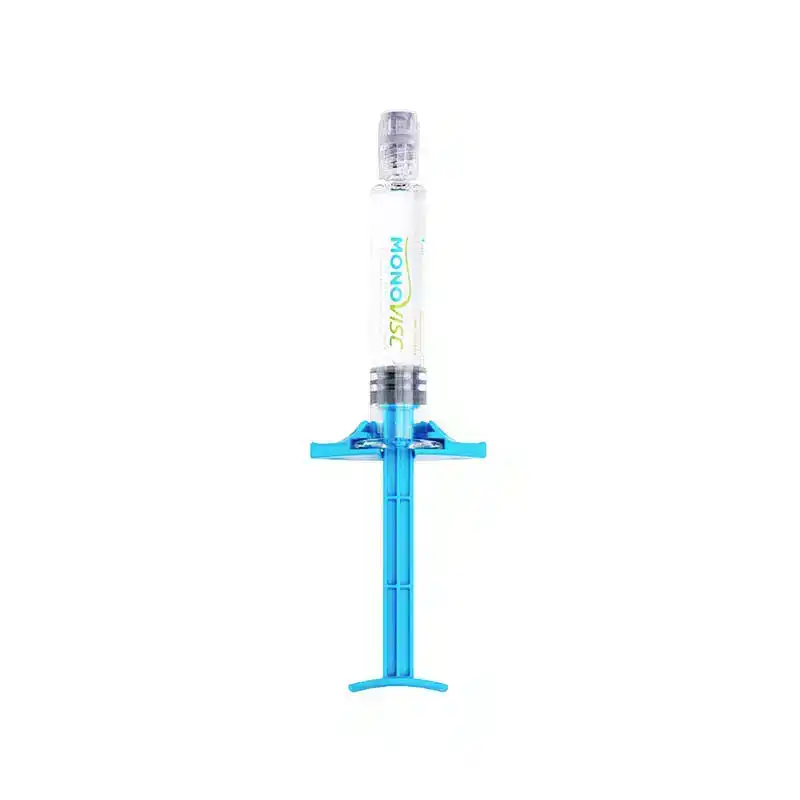Business Hours: Monday - Friday: 9 AM - 6 PM EST

Monovisc Prescribing Information
David Fuller
Last Updated On: October 1, 2024
According to the American College of Rheumatology, intra-articular injections are a standard treatment for knee osteoarthritis, providing significant pain relief for many patients. These treatments, including corticosteroids and hyaluronic acid, are often prescribed when other therapies fail to alleviate symptoms effectively.
Among these injectable treatments, Monovisc stands out. It is a single-injection hyaluronic acid product designed to lubricate the knee joint and reduce pain. Unlike multi-injection treatments, Monovisc offers the convenience of a one-time procedure, making it an attractive option for patients seeking efficient and long-lasting relief.
This article will delve into the Monovisc prescribing information, exploring its benefits, administration process, potential side effects, and patient suitability.
Key Takeaways
- Monovisc is a hyaluronic acid-based injection designed to relieve knee osteoarthritis pain.
- The recommended Monovisc dosage is a single 4 ml injection directly into the affected knee joint.
- Patients should be aware of Monovisc side effects, which include common reactions like pain and swelling at the injection site.
- Healthcare providers should closely monitor patients for potential adverse reactions and provide thorough patient counseling and informed consent before administering Monovisc.
About: Operating since 2016, Med Supply Solutions is known for being one of the industry’s top and trusted suppliers of cosmetic and viscosupplementation products. If you’re looking to buy Monovisc online, contact our sales department for more information.

MONOVISC®
SODIUM HYALURONATE
$349.00
Tier pricing
Save 2.87%
3 or more
$339.00 each
Save 4.3%
11 or more
$334.00 each
Save 5.73%
21 or more
$329.00 each
What is Monovisc?
Monovisc is a clear, sterile injection designed to relieve knee pain from osteoarthritis. It mimics the body’s natural joint fluid, relieving pain when standard treatments fail. Made from high-molecular-weight hyaluronan, Monovisc is intended for patients without success with other therapies.

- Administration: A single injection directly into the knee joint.
- FDA Approval: Approved for patients over 21 years old needing long-term relief.
- Dosage: 4mL per affected knee, with no more than one syringe at a time.
This convenient one-shot treatment offers hope for lasting pain relief, making it an essential option for those with chronic knee discomfort. Monovisc is specifically for adults, as its safety and effectiveness in children have yet to be established. Overall, it is vital for those seeking alternative solutions to manage osteoarthritis knee pain.
Dosage Guidelines for Monovisc
Finding the right dose of Monovisc is crucial for effective patient care. The Monovisc dosage is typically 4 mL, administered as a single injection directly into the affected knee joint. This hyaluronic acid injection is designed to mimic the natural synovial fluid, providing lubrication and cushioning for patients suffering from osteoarthritis-related knee pain.

Unlike other hyaluronic acid treatments that may require multiple injections, Monovisc knee injection is a one-time treatment. Patients only need a single injection to experience pain relief, which can last up to six months.
The maximum number of Monovisc knee injections is generally limited to one per treatment cycle. However, if the pain relief diminishes over time, patients may consult their healthcare provider to discuss the possibility of additional injections.
It is important to follow the guidance of a medical professional to determine the appropriate treatment plan based on individual needs and response to the initial injection.
Administration Routes for Monovisc
Monovisc is not administered intravenously. It is specifically designed for intra-articular injection into the knee joint to provide relief from osteoarthritis pain. Administering Monovisc through the veins would not be effective and is not recommended.

Similarly, Monovisc is not intended for subcutaneous administration. Injecting Monovisc under the skin would not deliver the hyaluronic acid directly to the knee joint, where it is needed to supplement the synovial fluid and provide pain relief.
Proper Injection Techniques
The success of Monovisc knee injections depends on proper injection techniques. To ensure optimal results, healthcare professionals should follow these steps:
- Use sterile gloves and prepare the injection area with an antiseptic solution.
- Select the correct knee joint for injection and position the patient for joint accessibility.
- Use a new, sterile syringe and needle for each injection to prevent infection.
- Draw the recommended 4 mL dosage of Monovisc.
- Inject the solution directly into the joint space, ensuring it is not injected into blood vessels, muscles, or skin.
- Slowly administer the injection to avoid pressure changes within the joint.
- Apply a small bandage after the injection and advise the patient not to rub the area.
- Monitor the patient for any immediate side effects or reactions post-injection.
Contraindications for Monovisc Use
Before using Monovisc, know this: some people should not get it due to allergies to its ingredients, infections at the spot of injection, or joint issues they already have.
- Allergies to Hyaluronan Products: Individuals allergic to hyaluronan should avoid Monovisc, as it contains this sugar. Allergic reactions can worsen their condition, making it crucial to screen for such allergies before treatment. Patients with previous adverse reactions to similar products may also react negatively. Prioritizing patient safety is essential.
- Infection at the Injection Site: Infection at the injection site poses a risk during Monovisc treatments. Doctors must thoroughly examine the knee for any signs of infection before administering the injection. If an infection is present, Monovisc should not be used. Maintaining a clean, sterile environment can significantly reduce the risk of this complication.
- Pre-existing Joint Infections: Patients with existing joint infections should not receive Monovisc. This treatment is specifically for osteoarthritis-related knee pain, and injecting it into an infected joint can exacerbate the issue. Doctors must assess the knee for any signs of infection beforehand to ensure the safety and efficacy of Monovisc for patients in need.
Safety Considerations for Monovisc
When using Monovisc for osteoarthritis, it’s important to consider potential side effects, monitoring, and patient consent. Common side effects like pain, swelling, or redness at the injection site are usually mild and resolve quickly. Rarely, allergic reactions to hyaluronan may occur, so screening is essential.
Monitoring for complications, such as infection or severe joint discomfort, is critical. Healthcare providers should closely observe recovery, especially when using Monovisc’s single-injection approach. Sterile techniques during the procedure minimize infection risks.
Patient counseling and informed consent are vital. Doctors may compare similar treatments, such as Monovisc vs Orthovisc, and discuss this with their patients to ensure they make informed decisions about the procedure. Clear communication helps patients feel prepared and confident in their care.
Conclusion
Monovisc has proven to be an effective, single-injection treatment for osteoarthritis-related knee pain. It provides long-lasting relief for many patients and is a convenient alternative to multi-injection therapies. While generally safe, it is essential to be aware of potential side effects and contraindications and ensure patients receive appropriate counseling and monitoring.
FAQs
1. What is the correct dosage for Monovisc?
The recommended dosage is a single 4 ml intra-articular injection administered directly into the knee joint. Consult your doctor for personalized advice.
2. Are there side effects associated with Monovisc?
Yes, Monovisc may cause side effects such as pain, swelling, or redness at the injection site. In rare cases, patients might experience more severe reactions.
3. Is Monovisc safe for everyone?
Monovisc should not be used by individuals allergic to hyaluronan, those with infections at the injection site, or pre-existing joint infections.
4. How long does Monovisc provide pain relief?
Monovisc can offer relief for up to six months, although the duration may vary depending on the patient.
References
Buelt A, Narducci DM. Osteoarthritis Management: Updated Guidelines from the American College of Rheumatology and Arthritis Foundation. American Family Physician. 2021;103(2):120-121. https://www.aafp.org/pubs/afp/issues/2021/0115/p120.html
Two New Intra-Articular Injections for Knee Osteoarthritis. JAMA. 2018;320(21):2262. doi:https://doi.org/10.1001/jama.2018.13134
Products
Cart
Log In
Newsletter
Subscribe for exclusive offers and updates on new arrivals
Share feedback at:
Working Hours
Monday to Friday: 9 AM to 6 PM EST
The Most Popular Brands
Med Supply Solutions
Support
Copyright 2025. Med Supply Solutions